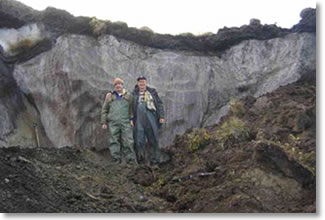Scientist sees changes on warmer North Slope of Alaska
6/19/06By Ned Rozell
Truck-size wedges of underground ice that have remained in place for thousands of years on Alaska's North Slope seem to be thawing, according to a scientist doing work for an oil company there.
Permafrost scientist Torre Jorgenson of Alaska Biological Research, Inc. was checking out an area west of the Colville River recently when he noticed water-filled pits that weren't in Navy photographs of the area from 1945.
"We were doing baseline studies on permafrost stability for ConocoPhillips and were looking at lake erosion, but when we saw the historical photos we said 'Wow, there's a lot going on here,"' Jorgenson said.
Walking in hip boots on the tundra surface of the North Slope, Jorgenson and his colleagues-Erik Pullman of Alaska Biological Research and Yuri Shur of the University of Alaska Fairbanks-saw many waterholes on the tundra. Some were new pits with bright green tussock heads nodding into them; the vibrant color indicated the tundra plants were getting a temporary blast of nutrients and water as the ice wedge beneath them thawed. Other, older pits had drowned tussocks in them.
Ice wedges are underground chunks of ice about six to nine feet wide on top and then extend nine to 12 feet to a tapered end that points downward. They exist only in places where the yearly average temperature is well below freezing. Ice wedges form just below the layer of soil that freezes every winter and thaws each summer, and they endure longer than civilizations.
"For these to have developed over thousands of years, there had to be relatively stable temperatures," Jorgenson said. "Their thawing shows that today's temperatures are beyond normal fluctuations."
The ice wedges that are thawing on the North Slope are special features of a cold landscape, Jorgenson said, and are not to be confused with the deep permafrost locked in the soil beneath them.
"We're not talking about (typical) permafrost disappearing up there; it's still pretty cold permafrost and it's 600 meters (about 1,800 feet) deep in places," Jorgenson said. "It's not going to disappear anytime soon."
The prehistoric ice wedges of the study area west of the Colville River, smaller and more vulnerable to warmer temperatures than the deep permafrost, are thawing so quickly that Jorgenson teamed with his coworkers to write "Abrupt increase in permafrost degradation in Arctic Alaska," published in the January 24, 2006 issue of Geophysical Research Letters. They based their conclusions on the 1945 Navy photos and aerial photos taken in 1982 and 2001, along with their observations from the ground.
When working around the collapse pits, Jorgenson, Shur and Pullman also noticed "a violent degassing of methane." Methane, a greenhouse gas four times as effective at trapping heat than carbon dioxide, is in large supply in the frozen areas of the world. The gas is a product of decomposition of plants, and frozen ground locks it in.
"When we were walking in these troughs and stirring things up, the water was roiling with (methane) bubbles," Jorgenson said. "You can smell it escaping, and we've lit it with a match."
Thawing ice wedges up north complicate what scientists think about greenhouse gases and the Arctic. Some think arctic tundra has become a "carbon source" that releases more greenhouse gases than it takes in. The collapsing pits, which may someday cover up to 30 percent of the lowland landscape, appear to release methane when they first collapse, but then accumulate carbon as the wedges become overgrown with sedges and peat, Jorgenson said.
While the carbon equation of thawing ice wedges is uncertain, the researchers think they have an idea why the ice wedges are collapsing. An unusually warm, wet period on the North Slope that started in the summer of 1989, followed by record-breaking temperatures in the 1990s, may have pushed the ice wedges past a threshold of warmth they hadn't experienced for thousands of years.
Courtesy the Geophysical Institute


